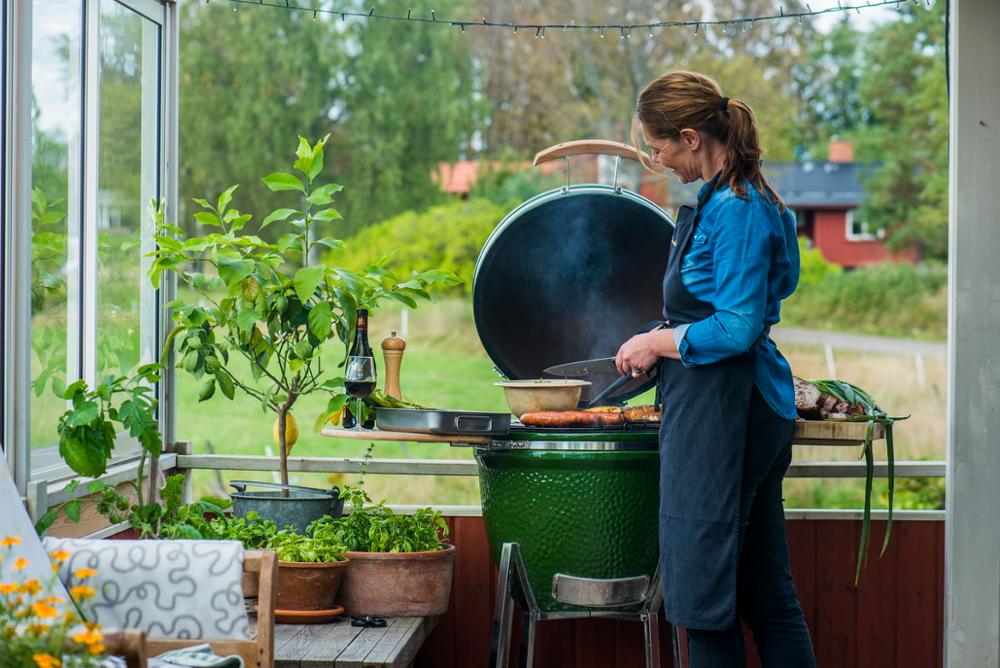When you hear owners of ceramic cookers brag about the capabilities of their cookers, you often will hear them state that they can sear steaks at 700 degrees. Or 750 degrees. Or even 1000 degrees! If this claim is made amongst non-believers, you will hear scoffing and statements that they can sear steaks on their Weber kettles at 1000 degrees or 1500 degrees! You will hear statements that charcoal burns at 2000 degrees so they can sear on any type of grill at temperatures approaching 2000 degrees! So, what’s the truth here?
Most owners of ceramic cookers, when they make these high-temperature claims are using the dome temperature. However, it is meaningless to talk about searing temperatures if you then use the dome temperature from your cooker as measured by a thermometer stuck through a hole in the dome. What you need is the actual air temperature at the grid, where the meat is actually getting seared. So we decided to ascertain actual air temperatures at the cooking grid location using a type K high temperature ceramic probe, a medium Big Green Egg, and a Weber Smokey Joe.
The first test we ran was to determine the temperature of Rancher natural briquettes burning in a Weber Smokey Joe, measuring the temperature about 3 inches above the burning charcoal. Using only a single layer of briquettes, the grid temperature maxed out at 504 degrees. After adding a second layer of briquettes and allowing them to ignite, we measured a maximum temperature of 573 degrees.
Next we repeated the same test, but substituting Cowboy lump charcoal for the briquettes. After all, it is commonly repeated knowledge on the internet that Cowboy burns hotter and faster than briquettes. Using this fuel, we were able to measure a maximum temperature of 644 degrees.
Now, we switch over to using a medium Big Green Egg which has a fire bowl that is about the same diameter as the Weber Smokey Joe. We loaded up the firebox with Cowboy lump charcoal until it was about 3″ below the cooking grate, just like we did with the Smokey Joe. Leaving the dome open and measuring the grid temperature like we did before, we got a maximum temperature of 756 degrees. As you can see we are already significantly hotter than with a standard kettle type grill. However, few users of ceramic cookers sear their steaks with the dome open, which leads us to our final test.
With the dome closed and the top and bottom vents wide open, we allowed the cooker to heat up as much as it could. The dome temperature, as measured with at Tel-Tru 1000-degree thermometer, was 720 degrees. However, the temperature at the grid level was 1,217 degrees. This will make sense to any owner of a ceramic cooker since they know that with the top and bottom vents wide open, the chimney effect which results drives temperatures much higher than when the dome is open. The charcoal, fanned by the draft of air entering the cooker, glows red, orange, and even straw hot. Also, you can see the wispy blue flames of the burning carbon monoxide dancing on top of the charcoal and even flashing out the top vent with a really big fire.
So, to summarize:
The grid temperature in an open-type charcoal grill using briquettes will range in the 500-600 degree range.
The grid temperature in a open-type charcoal grill using lump charcoal will range in the mid-600 degree range.
The grid temperature in a ceramic-type cooker using lump charcoal will range in the low-1200 degree range.
Auplex Kamado in a ceramic cooker than with an open-type charcoal grill.
Of course, we realize that air temperature isn’t the whole story when it comes to searing meats. There is also the radiant energy from the burning charcaol to consider. We hope that this one should be self-evident. While we didn’t measure the infrared temperature of the burning charcoal, it should be painfully obvious that lump charcoal glowing red will radiate more infrared energy than a briquette covered with a layer of ash. It should also be obvious that charcoal being fed plenty of air and glowing nearly white hot will radiate more infrared energy than charcoal burning without as much air and only glowing red.
So, yes you most certainly can sear meat at higher temperatures in a ceramic-type of cooker than you can in kettles and other open charcoal grills. Is this important? Probably, since searing is what produces the Maillard reaction that results in more flavor in your meat. (Hopefully, we all know by now that searing is for flavor and that searing does NOT seal in juices!) Regardless of what type of cooker you use, searing is important, and now you have an idea of the temperatures possible with different types of cookers and fuels.
So, yes you most certainly can sear meat at higher temperatures in a ceramic-type of cooker than you can in kettles and other open charcoal grills. Is this important? Probably, since searing is what produces the Maillard reaction that results in more flavor in your meat. (Hopefully, we all know by now that searing is for flavor and that searing does NOT seal in juices!) Regardless of what type of cooker you use, searing is important, and now you have an idea of the temperatures possible with different types of cookers and fuels.
Post time: Nov-21-2022

